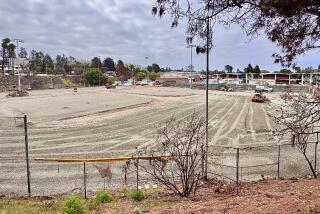Big Belmont Questions
- Share via
The recommendation to complete the Belmont Learning Complex on an abandoned oil field tainted with potentially explosive methane gas and other toxic chemicals raises major common sense questions for the Los Angeles school board. The most urgent remains--given the tainted history and inevitable liability linked to the nearly complete school--aren’t there better alternatives?
The surprising recommendation to proceed was made by a divided Belmont Commission, a citizens panel appointed by the school board after members were frustrated by a flood of contradictory and inaccurate information from district staff.
The final fate of the campus just west of downtown will be decided by a reform-minded board that is especially vigilant after learning of an inadequate environmental assessment, warnings ignored by staff and millions already spent on the project. Completing the campus could bring the total cost to $300 million, according to the commission, about doubling what has already been spent. Why wouldn’t building several smaller high schools be more cost effective and better educationally for students?
The board must ask: Is it cheaper to fix Belmont? Commissioners accepted expert testimony that technology could mitigate the dangers. How much would that cost? The commission does not answer that obvious question.
Where would the district get the money to pay for independent monitoring for the next 75 years, the time frame cited by the commission for the life of the school? Since the commissioners said they don’t trust district staff to do the oversight--a wise caution given what we know--then who would? The commission does not answer that either.
Meanwhile, annual budget battles indicate there is never enough to pay for instructional priorities, union demands and proper maintenance of existing facilities, let alone cover an unknown cost that could grow big as the trees.
And what would discourage the litigation that surely will be filed by environmental activists or concerned citizens to stop construction? Would the district somehow be released from liability if students or faculty later claimed the school site contamination caused their cancers or other health problems?
The Belmont fiasco has been brewing for a decade, and now the commission predicts the campus could take four or five additional years to finally complete. While this prolonged debate continues, 2,400 high school students are bused involuntarily from their neighborhood high school because of overcrowding. Another 5,000 students attend the old Belmont high school, which is so crowded that some do not have desks in every class. This is not quality education.
The Belmont Commission recommendation raises more uncertainties about risks, liabilities, costs and unforeseen problems that could financially strangle the district.
The board needs to think about building schools in a new way. Longtime state education codes require large amounts of land to build a high school. In a built-out urban area, that no longer makes sense. If the board would have to spend another $150 million to finish Belmont--not counting the endless monitoring costs--why not take that money and build smaller, easier-to-locate campuses? The board needs to ask these questions and a whole lot more.
More to Read
Sign up for Essential California
The most important California stories and recommendations in your inbox every morning.
You may occasionally receive promotional content from the Los Angeles Times.













